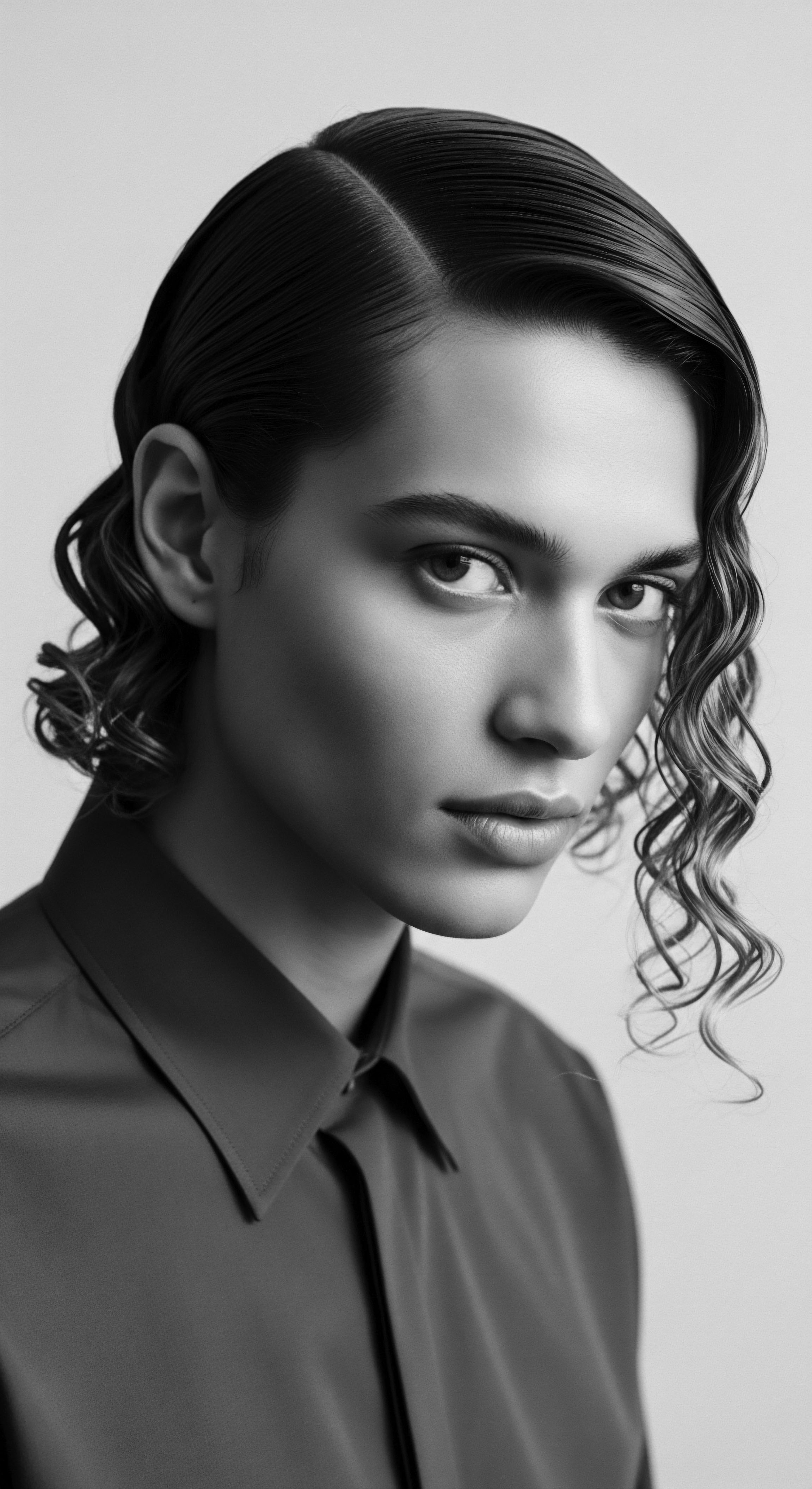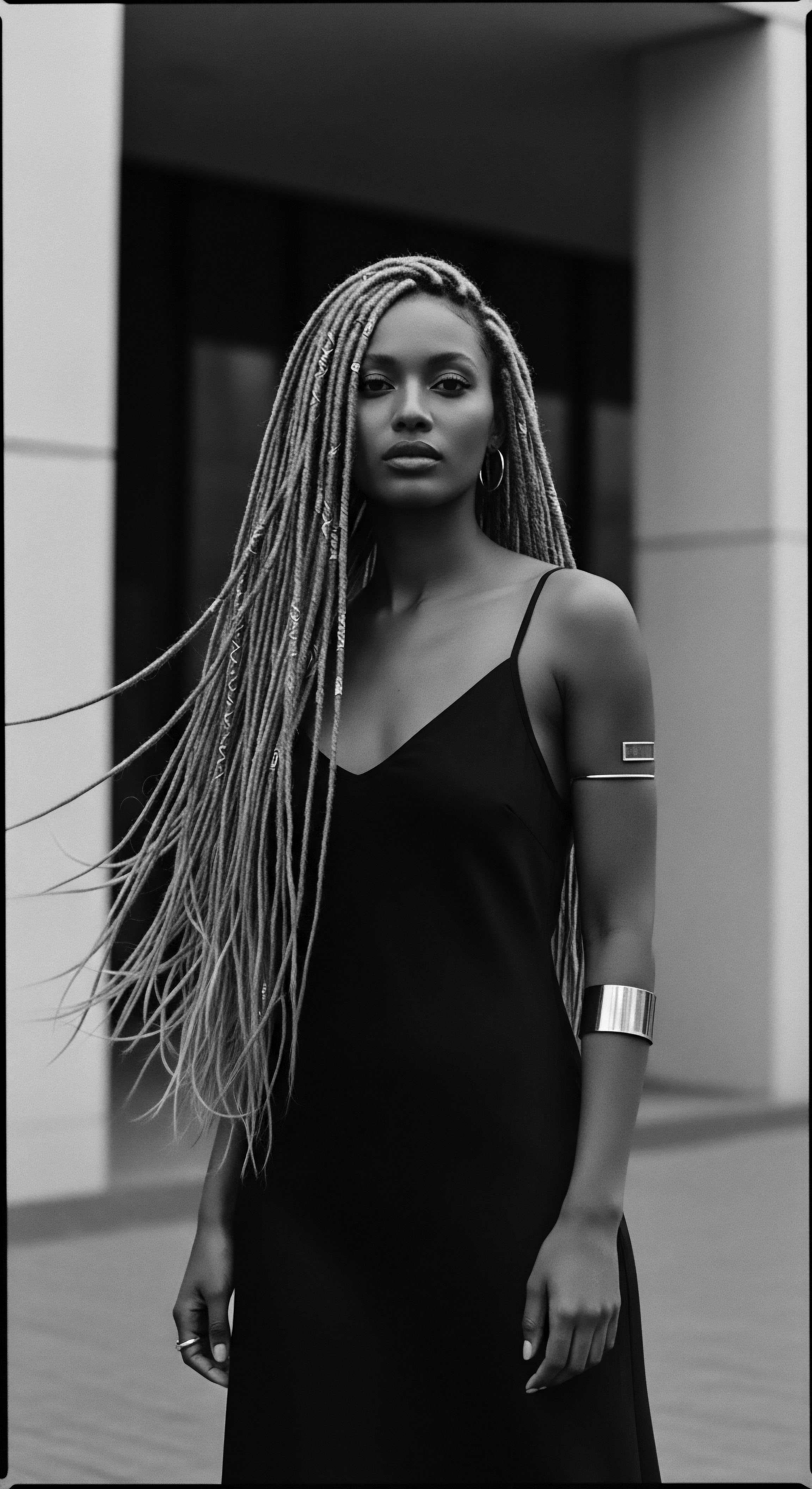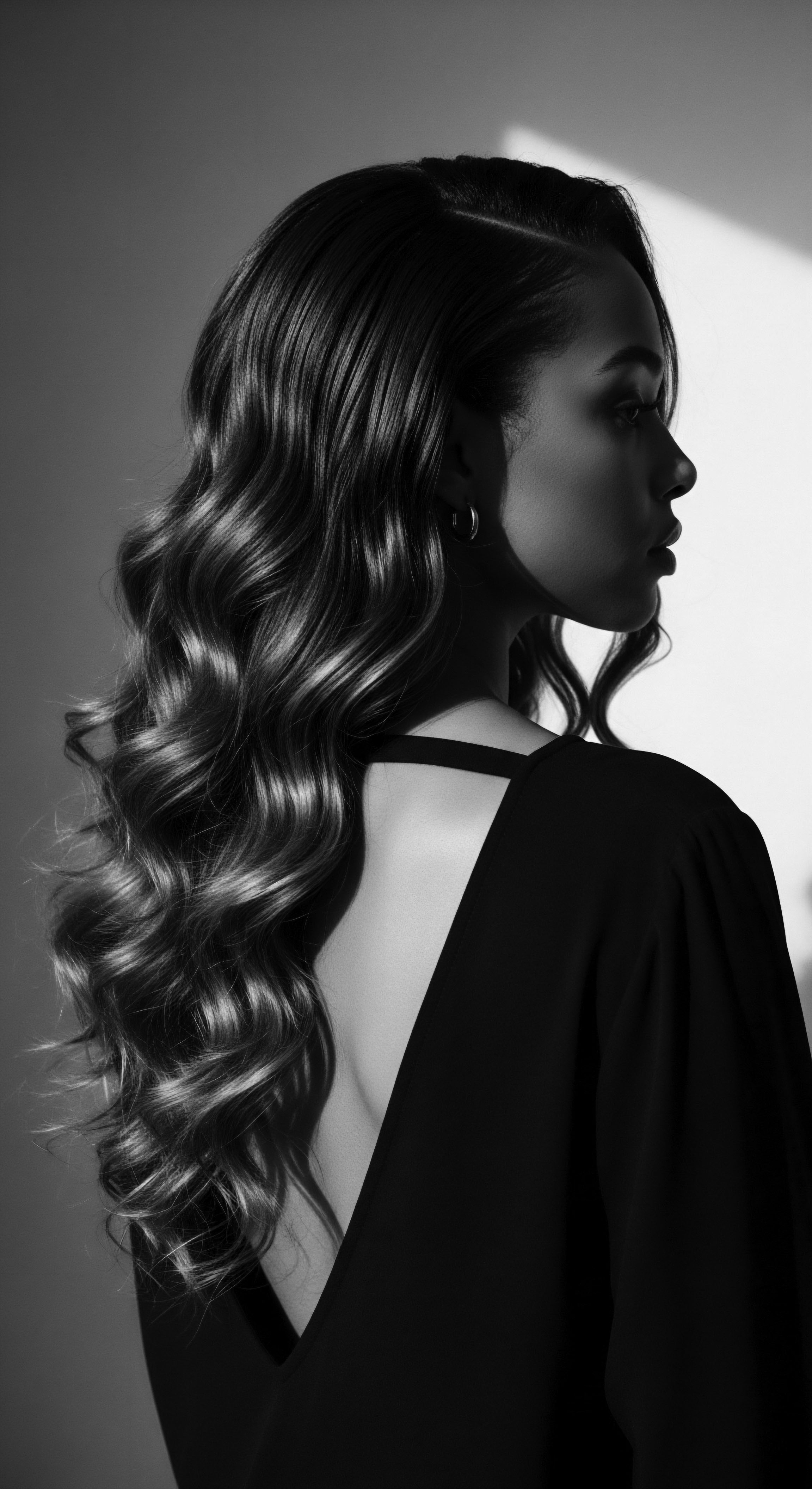
Roots
There exists within each strand of textured hair a memory, a story whispered from epochs past, a biological blueprint etched by ancestral journeys across continents and climates. To truly understand the necessity of specific care for textured hair, one must listen to these whispers, recognizing that our coils, kinks, and waves are not mere aesthetic choices, but intricate biological marvels, deeply connected to a profound human heritage. This is not a superficial matter of daily regimen; it is a profound connection to the very fibers that have crowned Black and mixed-race communities for millennia, each curl a testament to resilience and adaptation.

What Unique Biological Features Shape Textured Hair’s Needs?
The core distinction of textured hair resides in its very architecture, a masterpiece of natural design. Unlike straight or wavy hair, which often boasts a more circular or slightly oval cross-section, hair with pronounced coil and curl exhibits an elliptical, almost ribbon-like shape when viewed under magnification. This particular geometry is not an arbitrary detail; it introduces a series of biological characteristics that necessitate specialized care. Imagine a long, slender ribbon continuously twisted upon itself.
At each twist and turn, the ribbon is inherently weaker, more susceptible to fracturing, and less capable of evenly distributing stress. This is the truth for textured hair strands.
Research confirms these intrinsic differences. A significant study by Franbourg et al. (2003) observed quantitative data on the morphology, structure, and mechanical properties of hair fibers from different ethnic origins. Their work revealed that while the basic intimate structures of hair fibers, such as keratin composition, did not differ across groups, the geometry, mechanical properties, and water interactions varied markedly.
Specifically, African hair presented a high degree of irregularity in its diameter along the shaft, alongside an elliptic cross-section. It frequently showed twists, with random reversals in direction and pronounced flattening. These structural nuances contribute directly to why our hair demands a tender touch, a different approach to cleansing, moisturizing, and styling.
Textured hair’s distinct elliptical cross-section and frequent twists create inherent points of fragility, influencing its moisture retention and mechanical strength.
The cuticle, the outermost layer of the hair strand, also plays a critical role. In highly coiled textures, these protective scales often lie less flat than on straighter hair, leaving the inner cortex somewhat more exposed. This arrangement, while allowing for magnificent volume and body, also permits moisture to escape more readily.
This predisposition to dryness is perhaps the single most significant biological reason textured hair hungers for consistent hydration, a wisdom intuitively understood by our forebears long before microscopes revealed the cellular intricacies. Their practices, honed through generations, sought to replenish this vital moisture, drawing from the bounty of the land.

How does Ancient Wisdom Reflect Hair’s Inherent Biology?
Ancestral practices, handed down through generations, speak to an innate understanding of these biological realities. In many West African societies, the application of natural oils and butters was a cornerstone of hair care, not merely for cosmetic appeal but for health and resilience. Shea butter, for instance, sourced from the karite tree, has been a sacred symbol and a staple for centuries, used to protect skin from harsh sun and wind, and to nourish hair. Women in communities throughout West Africa used it to moisturize and to aid in the creation of intricate styles, a practice deeply embedded in daily life and ritual.
The Himba people of Namibia, for example, traditionally use a mixture of ground ochre, goat hair, and butter to dreadlock their hair, a method that both styles and protects, indicating a deep ancestral knowledge of sealing and fortifying the strands against environmental elements. This blend, rich in lipids, would have offered a protective barrier, compensating for the hair’s tendency to lose moisture quickly. The ancient Egyptians, too, understood the need for hair protection, often shaving their heads and wearing wigs to shield their scalps from the sun. These methods, born of necessity and wisdom, implicitly acknowledged the hair’s vulnerability and its need for a diligent, protective embrace.
The biological disposition of textured hair to dryness and fragility means it also experiences unique challenges during the hair growth cycle. While the cycle itself (anagen, catagen, telogen) remains universal, the tightly coiled structure can lead to tangling and knotting, which, if not managed with intentional care, can cause breakage and hinder visible length retention. This calls for gentle handling, a lesson learned and taught through generations of styling traditions. The history of hair care is a testament to observing the hair’s natural inclinations and developing methods that work in harmony with its distinctive biology, rather than against it.

Ritual
The care of textured hair is, and always has been, a ritual—a tender thread connecting the present to a vibrant past. It is in the deliberate acts of cleansing, detangling, nourishing, and styling that the biological needs of our hair are met, practices that have been refined over countless generations. These rituals are not static; they are living traditions, adapting while holding fast to the wisdom of antiquity, where the hair itself was a marker of identity, status, and community. In 15th century West Africa, for instance, hair was a profound identifier, capable of conveying a person’s age, religion, social rank, marital status, or even family lineage.

What Traditional Styling Approaches Protect Textured Hair?
Protective styles stand as a testament to this enduring wisdom, born from an intuitive understanding of how to safeguard vulnerable hair strands. Styles like cornrows, Fulani braids, and Bantu knots are not simply aesthetically pleasing; they are deeply rooted in ancestral methods of preserving hair integrity. By gathering the hair into structured forms, these styles minimize exposure to environmental elements, reduce mechanical stress from daily manipulation, and aid in length retention.
The act of braiding was often a communal activity in African cultures, strengthening bonds between women who would spend hours, sometimes days, creating these intricate designs. This shared experience underscored the profound social value of hair care, transforming a biological necessity into a communal celebration.
| Traditional Practice Protective Braids (e.g. cornrows, Fulani) |
| Biological Rationale Minimizes external friction and tangling, reducing breakage at fragile points along the helix. |
| Traditional Practice Natural Oils/Butters (e.g. shea butter, palm oil) |
| Biological Rationale Replenishes lipid barrier, seals cuticle, prevents moisture loss from hair's open structure. |
| Traditional Practice Hair Threading (Yoruba 'Irun Kiko') |
| Biological Rationale Stretches hair gently without heat, creating elongation while reducing shrinkage-induced tangles. |
| Traditional Practice Headwraps (e.g. gele, doek) |
| Biological Rationale Shields hair from sun, dust, and environmental damage, preserving moisture and style. |
| Traditional Practice These methods exemplify the deep, inherited knowledge of caring for textured hair's unique structure and needs. |
Consider the Yoruba people of Nigeria and their tradition of hair threading, known as ‘Irun Kiko.’ This technique, noted as early as the 15th century, involves wrapping thread tightly around sections of hair. It was a primary means of hair care, believed to bring good fortune, and is effective for length retention. The biological benefit resides in the gentle stretching and elongation of the hair without heat, reducing the tight curl pattern that contributes to tangling and breakage. This method effectively protects the hair from environmental damage and friction, offering a sophisticated alternative to modern straightening methods, all while supporting the hair’s delicate architecture.

How Have Care Tools Evolved, and What do They Tell Us about Hair Heritage?
The tools of textured hair care, too, hold centuries of stories within their design. From carved wooden combs used for detangling and sectioning to specialized tools for creating and adorning intricate styles, each implement served a specific purpose, reflecting a deep understanding of the hair’s unique properties. While modern tools have evolved, their fundamental purpose often echoes these ancestral designs. The wide-toothed comb, for instance, a staple in contemporary textured hair care, parallels the need for gentle separation that would have been addressed by traditional African combs, designed to navigate the hair’s natural coils without causing undue stress or breakage.
The objective has always been to work with the hair’s natural propensity for coiling, not against it, minimizing mechanical manipulation that can lead to damage. This consistent approach underlines the long-standing recognition that textured hair, with its inherent fragility, demands a different type of interaction.
The historical continuity of protective styling and tool design underscores an ancient, intuitive understanding of textured hair’s biological requirements.
The journey of hair care, particularly for Black and mixed-race communities, has also encompassed periods of adaptation and resilience. During the transatlantic slave trade, many Africans had their heads shaved for sanitary reasons, stripping them of a profound aspect of their identity. Despite this trauma, the practice of braiding persisted as a quiet, powerful act of resistance and cultural preservation. Enslaved Africans would braid their hair to remain connected to their heritage, even relying on less ideal substances like bacon grease or kerosene when traditional products were unavailable.
Cornrows, in particular, were used as a means of communication, sometimes even hiding seeds to aid survival, proving that hair care was never just about aesthetics; it was about life, identity, and enduring spirit. This historical narrative serves as a stark reminder of the intrinsic biological vulnerabilities of textured hair when denied proper care, and the ingenious ways ancestral wisdom persevered.

Relay
The legacy of textured hair is a living archive, continuously expanded by each generation that discovers, cares for, and celebrates their coils. The biological reasons textured hair needs specific care are not confined to academic studies; they manifest in the daily rituals that connect us to a past rich with ingenuity and strength, shaping how we voice our identities and shape our futures. This ongoing exchange, a relay of wisdom across time, affirms that understanding our hair is understanding a vital aspect of our ancestral story.

How does the Unique Structure of Textured Hair Influence Its Water Retention and Fragility?
At the heart of textured hair’s care lies its distinct hydro-behavior and mechanical properties. Franbourg, Hallegot, Baltenneck, Toutain, and Leroy’s (2003) work highlighted that African hair exhibits a lower percentage of radial swelling in water compared to Caucasian and Asian hair. While the chemical composition and intimate structures of the hair fibers themselves did not differ significantly, this distinct hydration characteristic suggests potential differences in other compositional aspects, particularly lipids, which influence how water interacts with the hair. This lower swelling capacity, combined with the hair’s elliptical cross-section and numerous twists, contributes to its propensity for dryness and heightened fragility.
Each twist along the hair shaft represents a potential stress point, a site where the cuticle layer may be more prone to lifting or even fracturing. This mechanical vulnerability means textured hair requires a gentler touch during detangling and manipulation, a reality long understood in ancestral practices of careful handling.
The very nature of its coiling makes textured hair more susceptible to tangles, which can lead to breakage if not managed with intentional techniques. The hair strands interlock with one another, forming knots and snarls that can be challenging to release without proper lubrication and a patient hand. This is where the wisdom of traditional practices, like meticulous sectioning and liberal application of natural emollients before detangling, becomes not just cultural but also biologically sound. These methods minimize the friction and tensile stress that can easily sever strands at their points of highest curvature.
- Shea Butter ❉ From the nuts of the karite tree, this rich butter has been a West African staple for centuries, prized for its ability to moisturize and protect hair. Its lipid content likely helps replenish the natural oils that textured hair may lose more readily.
- Chebe Powder ❉ Used by Chadian women, often mixed with shea butter, it is applied to hydrated hair and then braided. While not a growth stimulant, it aids in length retention by filling shaft spaces and sealing the cuticle, preventing breakage.
- Coconut Oil ❉ Known across many African and diasporic communities, its molecular structure allows it to penetrate the hair shaft, reducing protein loss and helping to fortify the strand from within.
- Aloe Vera ❉ Used traditionally for its soothing and moisturizing properties, it helps to hydrate and condition the scalp and hair, promoting a healthy environment for growth.

How do Ancestral Practices Continue to Inform Holistic Hair Health?
The connection between hair health and overall wellbeing, a concept now gaining traction in modern wellness circles, is deeply rooted in ancestral philosophies. For many African communities, hair was not separate from the body or spirit; it was an extension of one’s identity, a sacred part of self. The meticulous care of hair, therefore, was a holistic practice that encompassed physical, spiritual, and communal dimensions. This perspective underscores why issues like dryness and fragility, if left unaddressed, do not just impact hair’s appearance; they can affect an individual’s sense of self and connection to their heritage.
Nighttime rituals for textured hair, for instance, are not merely about preserving a style; they are a direct response to the hair’s biological needs for protection and moisture retention. Headwraps, known by various names such as ‘gele’ in Nigeria, ‘dukus’ in Ghana, or ‘doeks’ in South Africa, have a complex and meaningful history. In many African cultures, they were symbols of heritage, status, and spirituality, protecting hair from the elements and indicating social standing. Later, during times of enslavement in the Americas, head coverings were sometimes forced upon Black women as a symbol of subservience.
However, Black women reclaimed these coverings, transforming them into powerful expressions of resistance, beauty, and cultural pride. This resilience, reflected in the enduring practice of hair wrapping, is a direct answer to the biological need to protect textured hair from friction, especially while sleeping, preventing breakage and preserving moisture, a practice that literally covers the hair in its ancestral embrace.
Nighttime hair protection, a practice with deep ancestral roots, directly addresses textured hair’s biological need for minimized friction and moisture preservation.
The sustained use of traditional ingredients speaks to an intuitive understanding of molecular benefits. While our ancestors may not have articulated the precise chemical composition of shea butter, they experienced its tangible benefits for moisturization and protection. The anti-inflammatory and antibacterial properties of ingredients like African black soap, made from plantain skins, cocoa pod ash, shea butter, and palm oil, highlight a sophisticated traditional pharmacology that addressed both scalp health and hair cleansing.
These practices were not random acts; they were responses to observed biological realities, passed down through generations, forming a continuous chain of knowledge that informs our contemporary understanding of textured hair care. This historical continuity provides a profound framework for personalizing regimens, allowing us to draw from both inherited wisdom and modern scientific insight to achieve optimal hair health, connecting us ever more deeply to our heritage.

Reflection
To contemplate textured hair is to gaze into a mirror reflecting millennia of human experience, resilience, and profound beauty. The biological distinctions that necessitate its unique care are not anomalies but rather profound expressions of adaptation, etched into each spiraling strand. The elliptical cross-section, the unique twist and turn of the curl, the particular way it interacts with moisture—these are not vulnerabilities, but rather invitations to a care that is intentional, respectful, and steeped in the wisdom of those who walked before us.
The journey from elemental biology, through ancient practices, to its role in shaping futures, paints a vivid portrait of hair as a living, breathing archive. It is a testament to the ingenuity of our ancestors, who, without the benefit of microscopes or laboratories, intuitively understood the language of their hair and devised rituals that sustained it. The deliberate choices made today about how we cleanse, nourish, and style our textured hair are echoes of those ancestral practices, a continuation of a tender thread woven through time.
Each application of a natural butter, every gentle detangling session, each protective style chosen, stands as an affirmation of heritage, a quiet revolution of self-acceptance that honors the past and empowers the future. The strand, in its very structure and in the care it demands, remains a potent symbol of identity, a constant reminder of the enduring beauty and power inherent in our collective story.

References
- Franbourg, A. Hallegot, P. Baltenneck, F. Toutain, C. & Leroy, F. (2003). African hair ❉ a comparative study of its mechanical and structural properties. International Journal of Dermatology, 42(S1), 1-6.
- Franbourg, A. Hallegot, P. Baltenneck, F. Toutain, C. & Leroy, F. (2003). Current research on ethnic hair. Journal of the American Academy of Dermatology, 48(6 Suppl), S115-S119.
- Wade, M. (2014). Investigating the origins of macroscopic variation in differential ethnic hair types (Doctoral dissertation, Cardiff University).
